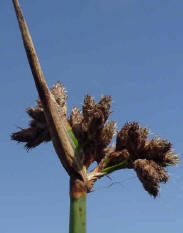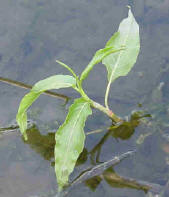|
 Broad
leaved Cattail Broad
leaved Cattail
Family Typhaceae (cattail)
Typha latifolia
Cattails are
rhizomatous perennial plants with long, slender green stalks topped
with brown, cigar-shaped flowering heads. They have been referred
to as the “supermarket of the swamps”. Flour is obtained from the
stems and the pollen. The starchy underwater stems and shoots taste
like cucumbers when eaten raw and like cabbage when boiled. The root
can be roasted or dried and ground into meal. New green “cat-tails”
can be boiled, buttered and eaten like corn on the cob. The Ohlone
Indians wove floor mats and roofing thatch from the leaves and used
the fluff as insulation and absorbent “diaper” material. |
|
  Hardstem
Bulrush, Native Tule Hardstem
Bulrush, Native Tule
Family Cyperaceae (sedges)
Scirpus acutus var. occidentalis
The tall stems
of this bulrush are round and bluegreen. The flowers occur in dense
spikelets borne at the top of the stem. The Ohlone Indians bound
bundles of tules together to make boats that were used in hunting
and fishing along San Francisco Bay. Air chambers in the hollow
stems kept the boats afloat. Long cylindrical stems from 5 to 8
feet tall leaves have slender, v-shaped blades. Flowers are
arranged as spikelets and resemble orange brown scales,
Reproduction is usually from underground stems. |
|
 Flat
Sedge Flat
Sedge
Family Cyperaceae (sedges)
Cyperus eragrostis
Flat sedges range in
height from .4 – 1 meter, and tolerates pH between 5 and 9. It is
sometimes referred to as umbrella sedge. It is found close to the
water’s edge because it prefers wet soil. This perennial has
greenish-yellow flowers are clustered in spikelets borne on round
heads. The stems are slightly triangular in cross section. It is
an invasive native weed. Flat sedge grows at the edges of ponds
and slow-moving creeks. |
|
  Water
Smartweed, Pink flowered knotweed Water
Smartweed, Pink flowered knotweed
Family Polygonaceae (buckwheat)
Polygonum coccineum
Smartweed is a perennial that reproduces by seed
and by long creeping rhizomes. It produces a deep rose pink flower
on a 7 cm long spike from May to November. The 4 to 14 cm long
lanceolate leaf is reddish near the base. Because it has swollen
nodes on the stems, it is sometimes called “knotweed”. This
semiaquatic plant is dormant in winter. |